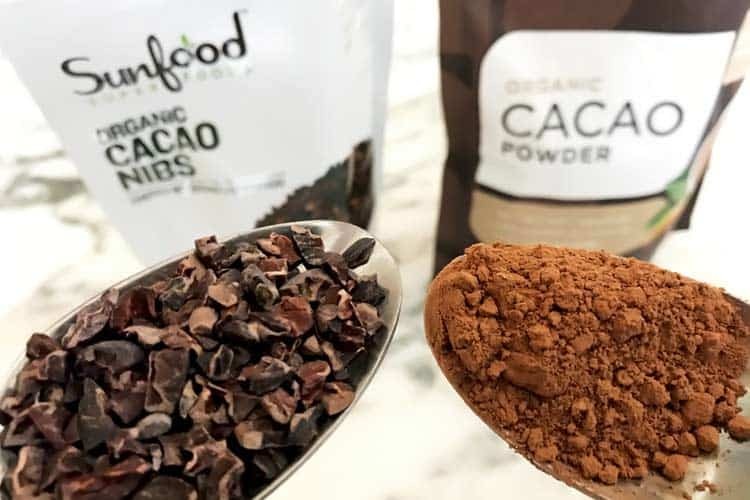
Are Cacao Nibs the Same as Chocolate and Good for You?
Cacao nibs come from cacao beans but aren’t as highly processed as chocolate. They’re the closest commercial product to the cacao bean. Cacao nibs have all the nutrients found in chocolate but don’t contain as many unhealthy additives.
What are cacao beans?
Cacao beans come from the plant Theobroma cacao. Humans have consumed these beans for thousands of years. They’re used to make cocoa and chocolate products.
The beans were domesticated and consumed by the ancient Mayan and Aztec civilizations in Mesoamerica. The Mayans called this bean the "food of the gods". Today, commercial cacao beans are mostly grown in West Africa and parts of Asia.
Once harvested, the beans go through a variety of processing stages. This produces a range of familiar products, including:
- Cacao nibs
- Cocoa powder
- Dark chocolate
- Milk chocolate
- White chocolate — using only the fats from the cacao bean
What are cacao nibs?
Cacao nibs are crunchy cacao bean pieces. The beans undergo commercial processing that turns them into nibs. This involves cleaning, roasting, and shelling the beans.
Not all cacao nibs are created equal. They come in various sizes, ranging from small to large bits.
Cacao nibs can undergo further processing to create cocoa powder or different types of chocolate. They are ground up and refined into sweet products. But they can also be eaten on their own or as a topping for certain foods.
What nutrients are in cacao nibs?
The exact nutrients in cacao nibs vary. The more processed nibs generally have less nutritional value, and the size affects the amount of processing.
Roasting can also modify the chemical composition of cacao nibs. Your best option is to look at nutrient labels on different brands of cacao nibs. Choose the one that suits your needs.
Regardless of brand, cacao nibs contain beneficial ingredients, including:
- Proteins
- Polyphenols — rich sources of dietary polyphenols like catechins and anthocyanidins
- Flavanols — naturally protect plants and benefit human health
- Methylxanthines — including theobromine and caffeine
- Potassium
- Phosphorus
- Copper
- Iron
- Zinc
- Magnesium
In 100 grams of Wegmans brand raw cacao nibs, there are:
- 13.3 grams of protein
- 53.3 grams of total fat
- 26.7 grams of carbohydrates
- 20 grams of fiber
- 73 milligrams of calcium
- 800 milligrams of potassium
- 67 milligrams of sodium
This brand doesn’t contain sugar or cholesterol. But 100 grams from another brand (Foods Alive) contains about 7 grams of sugar and more magnesium. Choose the one that fits your dietary needs.
QUESTION
How do cacao nibs compare to chocolate?
Cacao nibs are one of the healthiest chocolate relatives because they’re the least processed.
Milk chocolate and white chocolate are some of the most processed cacao bean products. They’re also the least healthy. Dark chocolate contains the highest percentage of cacao bean and is the healthiest of these processed alternatives.
All chocolate contains additives compared to pure cacao nibs, mainly dairy products. Cacao nibs are a fantastic dairy-free alternative to chocolate chips.
Chocolate also tends to have greater amounts of less-healthy ingredients, like fats and sugars.
For example, 100 grams of milk chocolate contains:
- 7.3 grams of protein
- 36.3 grams of lipids
- 50.5 grams of carbohydrates
- 50.5 grams of sugar
- 10 milligrams of cholesterol
- 3.2 grams of fiber
- 420 milligrams of potassium
- 262 milligrams of calcium
When you look at these numbers, milk chocolate is much worse for you than cacao nibs. Milk chocolate contains less protein, fiber, and potassium and has much more sugar, carbohydrates, fat, and cholesterol. The added dairy provides more calcium than cacao nibs, but there are healthier ways to get calcium than milk chocolate.
Dark chocolate is more comparable to cacao beans, but it’s slightly worse for you. It has less protein than cacao nibs. For example, a 100-gram serving of dark chocolate only contains 6.6 grams of protein, half the amount found in 100 grams of cacao nibs.
The main problem with cacao nibs compared to chocolate is their high polyphenol content makes them very bitter. You may find them difficult to adjust to if you’re used to sweet chocolate products. Luckily, their crunchy texture and bitter taste pair well with salads and other healthy meal options.
What are the health benefits of cacao nibs?
Chocolate’s health benefits have been debated for decades. The cacao bean contains many beneficial nutrients, each with its own health benefits.
Flavanols have fantastic antioxidant properties. They improve blood flow and reduce the risk of blood clots.
Methylxanthines have antioxidant and anti-inflammatory properties. They can help your gut microbiome by encouraging beneficial bacteria growth. They’re also known to enhance arousal, mood, and concentration levels.
In general, studies show that regularly eating small amounts of the healthiest types of chocolate can reduce the risk of:
- Coronary heart disease
- Stroke
- Type II diabetes
- Certain cancers (more research is needed to confirm these results)
Eating products like cacao nibs can also improve your cholesterol and blood sugar and lower your blood pressure.
Can cacao nibs cause health problems?
Eating cacao products in moderation is key. Studies consistently show that eating too much chocolate can lead to health problems, including obesity.
Cacao products can be a fantastic addition to your diet. They’re tasty and nutritious. Cacao nibs are one of your healthiest chocolate options.
Sources:
Baptist Health: "Health Benefits of Cocoa & 5 Easy Ways to Use It."
Food Research International: "The influence of the roasting process conditions on the polyphenol content in cocoa beans, nibs and chocolates."
Frontiers in Nutrition: "Cocoa, Blood Pressure, and Vascular Function."
International Journal of Environmental Research and Public Health: "Chocolate, "Food of the Gods": History, Science, and Human Health."
Nutrients: "Chocolate Consumption and Risk of Coronary Heart Disease, Stroke, and Diabetes: A Meta-Analysis of Prospective Studies," "Health Benefits of Methylxanthines in Cacao and Chocolate."
University of Kentucky Health Care: "In honor of World Chocolate Day, here are some recipes to help you celebrate (responsibly)."
Phytopathology: "The History of Cacao and Its Diseases in the Americas."
U.S. Department of Agriculture: "Cacao Nibs," "Raw Cacao Nibs."
U.S. Department of Agriculture: "Cacao Nibs," "Raw Cacao Nibs."


